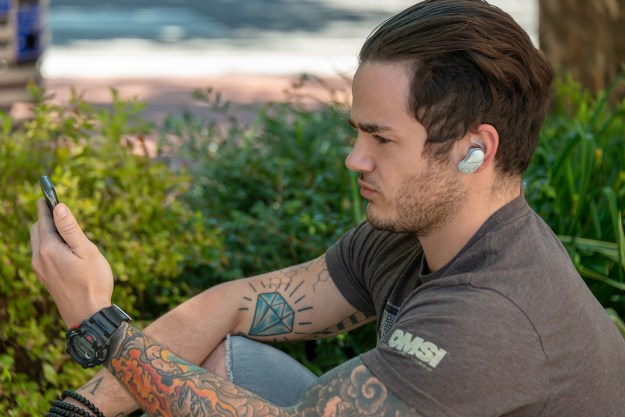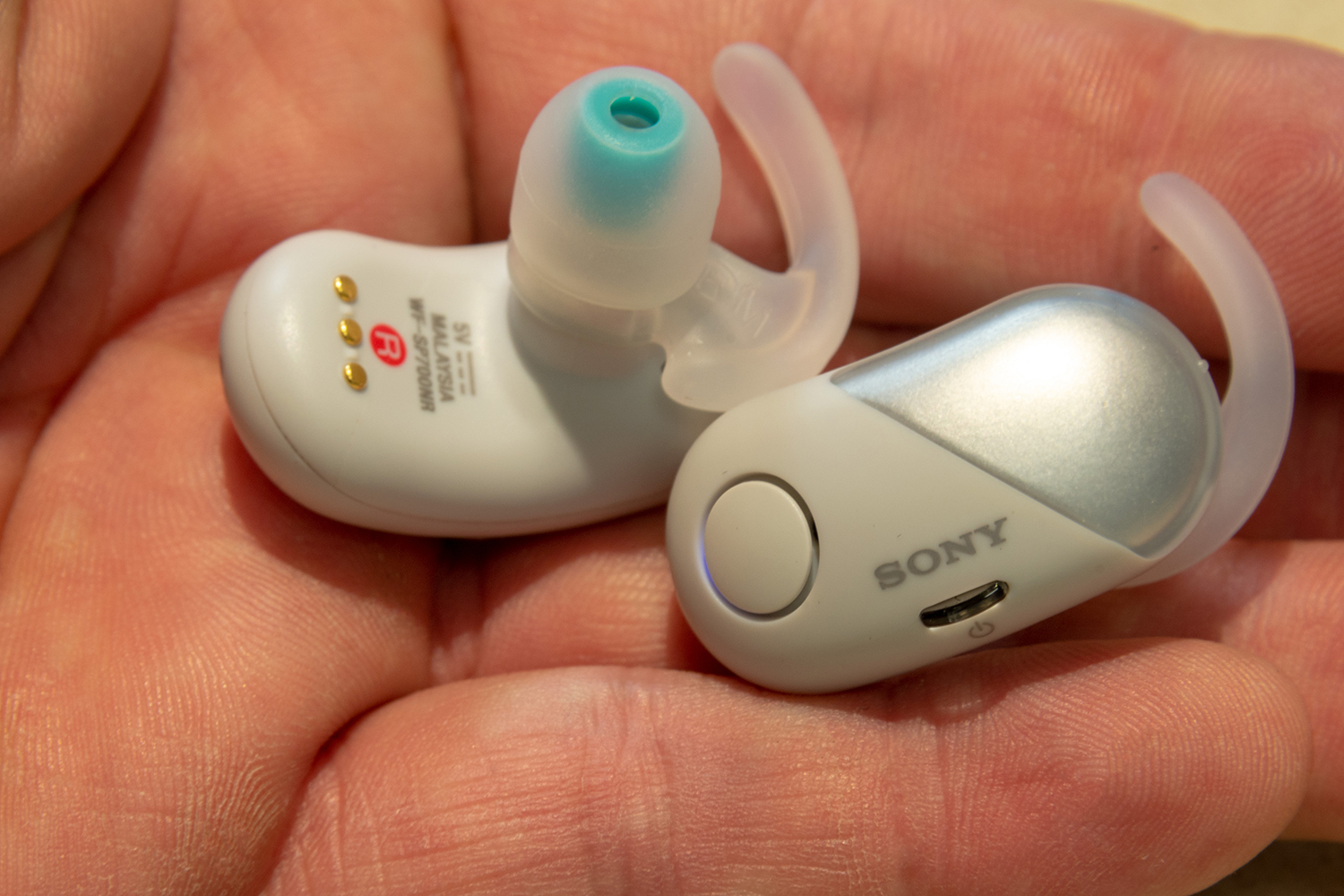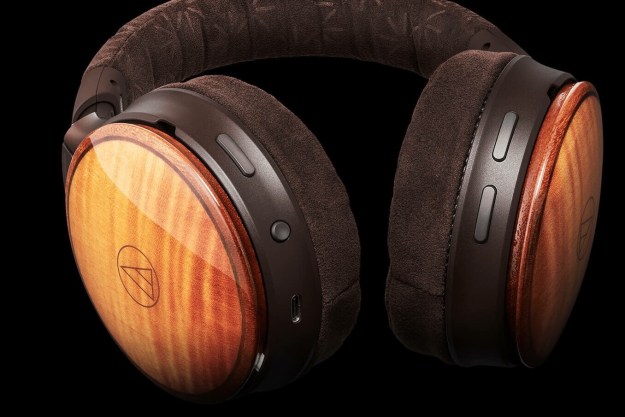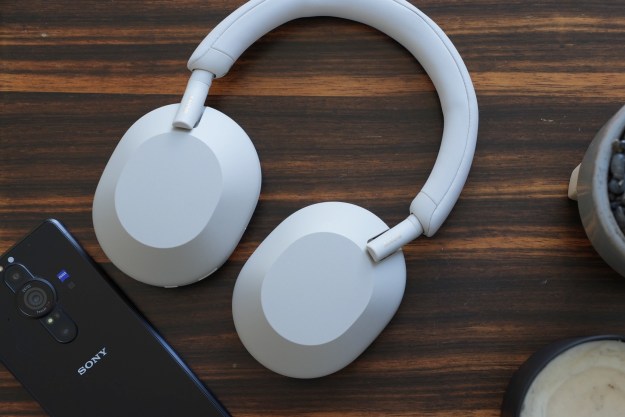
“They fit well and sound great, but the Sony WF-SP700N fall short on battery life, and that’s a deal breaker.”
- Extremely comfortable
- Clear sound with potent bass response
- Sweat-proof
- Battery 40 percent less than competition
- Poor noise-canceling
It wasn’t until very recently in the history of fully wireless headphones that we actually preferred a pair over banded-wireless headphones for daily use. The first generation of totally cord-free in-ears were lauded if they could simply maintain a connection to your phone — but times have changed. The bar has been raised considerably over the last year or so as companies like Jabra, Bragi and (industry leader) Apple presented fully wireless earphones that deliver great connection, decent battery life, and solid audio performance to boot.
With advanced features like active noise-canceling, custom equalization, and sweat-proofing, Sony’s fully wireless WF-SP700N look to join the top echelon of true
Out of the box
The WF-SP700N come in a small box with the
Features and Design
The SP700N offer a stylish finish, but their bulbous size is reminiscent of the once-popular Bluetooth headsets of yesteryear, commonly worn by fast-talking yuppies in convertibles. (In fact, they can even be used individually as single Bluetooth earpieces.) Curvy, lima-bean shaped
Once you put them in you’ll quickly forget you’re wearing them at all.
While some might be after a flashy set of in-ears to show off, these aren’t that; we honestly felt we looked like that same yuppie — now middle-aged — driving the same convertible and wearing the same headset in 2018.
Once you put them in you’ll quickly forget about how bulky they look to the outside world; in fact, you’ll forget you’re wearing them at all. The soft silicone tips and hyper-ergonomic sport fins combine to make the SP700N among the most comfortable fully wireless in-ears we’ve had the pleasure of wearing, with virtually no ear fatigue over hours of steady listening. They are also quite light and secure, allowing us to head bang to our favorite metal or run a fast-paced mile without so much as a single readjustment.

A small plastic button on the outside of the right earpiece allows you to play or pause music, and the same button on the left allows you to toggle the headphones’ built-in active noise cancellation, or pipe in a bit of the outside world via Sony’s ambient sound mode. That feature is similar to those we’ve seen from the Jabra Elite Active 65t and several others. Sony’s version comes in handy during bike rides and runs — situations where fully
Speaking of working out, the SP700N are IPX4 rated, which means the
Whatever you’re doing with the
The SP700N’s included charging case does add two full charges, but at a total of nine hours of juice, they lag significantly behind the 15 and 25 total hours offered by Jabra and Apple, respectively.
Setup/Connection
Setting up the Sony SP700N is a breeze, thanks to a sturdy Bluetooth 4.1 connection and voice instructions in the

The connection never dropped, even with our phone in a back pocket or backpack, and we were very satisfied with how quickly the
Audio performance
As you might expect from Sony, one place the SP700N really stand toe-to-toe with the best fully wireless in-ears we’ve tested is their audio quality.
That starts with their spectacular bass response. When listening to modern hip-hop from Kendrick Lamar, A$AP Rocky, and others, we were shocked with their ability to deliver the punchy, club-like low end that we wanted without overwhelming what was happening up top. That makes them very lively to listen to overall, and an absolute joy with any beat-driven tunes.
Sound quality stands toe-to-toe with the best fully wireless in-ears we’ve tested.
Even when listening to more acoustic-driven music from singer/songwriters like Elliott Smith and Ryan Adams we never felt like the lower frequencies of acoustic guitar sounded heavy or overwhelming. In fact, the SP700N’s high-end shimmer is always very pleasant, allowing the midrange of the vocals to tuck in beneath it with casual ease.
Sony also earns brownie points in terms of allowing listeners to customize the sound signature of the
In general, the SP700N rival wired in-ears we’ve tested at or around the $100 mark, and at this stage that’s an impressive feat for a set of fully

While we loved using the ambient sound input when working out, the noise-canceling tech seemed like an afterthought — unusual from a company whose WH-1000xM2 over-ears rank as our favorite noise-canceling option on the market. The SP700N’s noise cancelling does cut out some ambient noise, but it also comes with a noticeable high-end hiss, and it just doesn’t do enough to make it a compelling feature. We were also able to eek out a few more precious minutes from the miniscule battery with noise canceling off.
Warranty information
Sony offers a one-year limited warranty on defects from the factory.
Our Take
The WF-SP700N are comfortable, well-functioning fully wireless in-ears, but short battery life and an oversized design keeps them off our list.
Is there a better alternative?
Yes. The Jabra Elite Active 65t offers longer battery life, more balanced sound, and an even more life-proof design, and costs the same amount of money. Jabra’s original 65t – which offers nearly the same package, costs even less, as do Apple’s robust and popular AirPods.
How long will they last?
Sony has a history of manufacturing extremely high quality products, so we have no reason to believe the WF-SP700N won’t last through years of steady use. Unfortunately, their battery life is already behind the times, and it won’t be getting any better with age.
Should you buy them?
If you put comfort and quality bass response above all else, you might consider them. Otherwise, no. The WF-SP700N are totally decent (and extremely comfortable) fully wireless in-ears, but they simply can’t compete with similarly priced competitors in terms of battery life, and their biggest outstanding feature – noise canceling – just isn’t worth the effort.
Editors' Recommendations
- Sony’s ULT Power Sound headphones and speakers go big on powerful bass
- The best wireless headphones for 2024 from Bose, Sony, 1More and more
- Best Sony WH-1000XM5 deals: Save $70 on the wireless headphones
- Niche Canadian company takes on Sony with new wireless earbuds and headphones
- Sony debuts the WF-C700N, its most affordable noise-canceling earbuds






